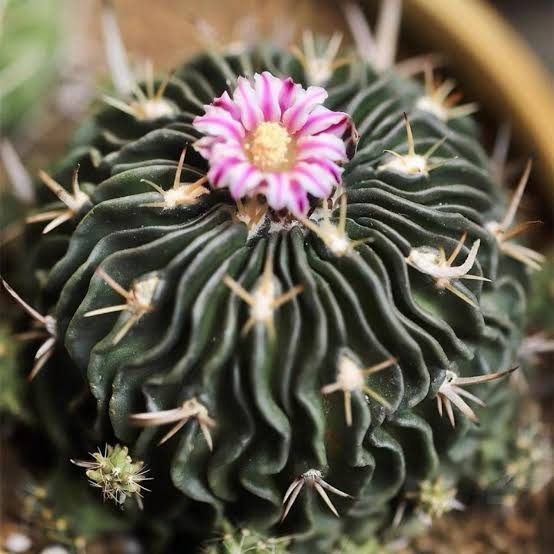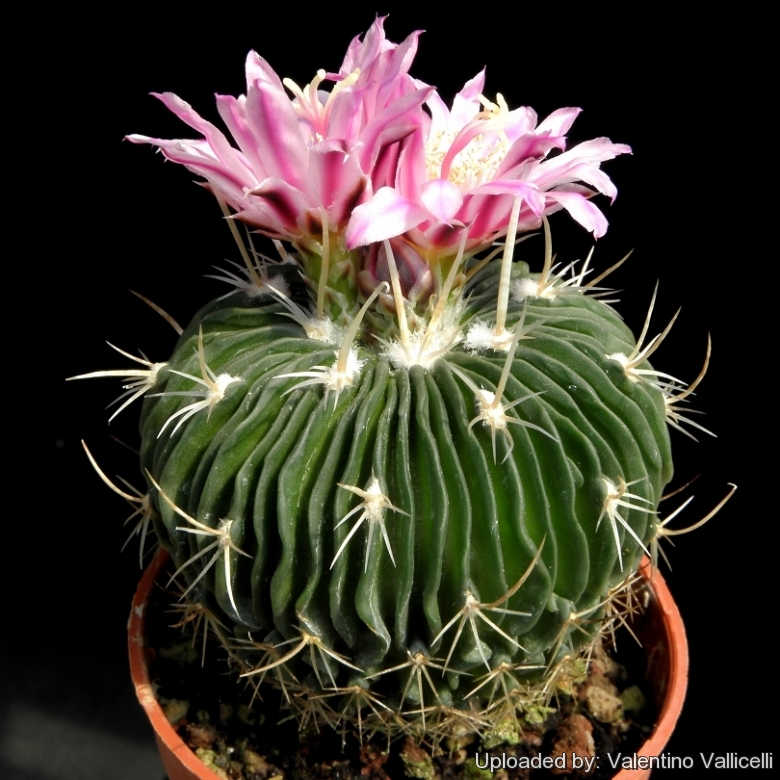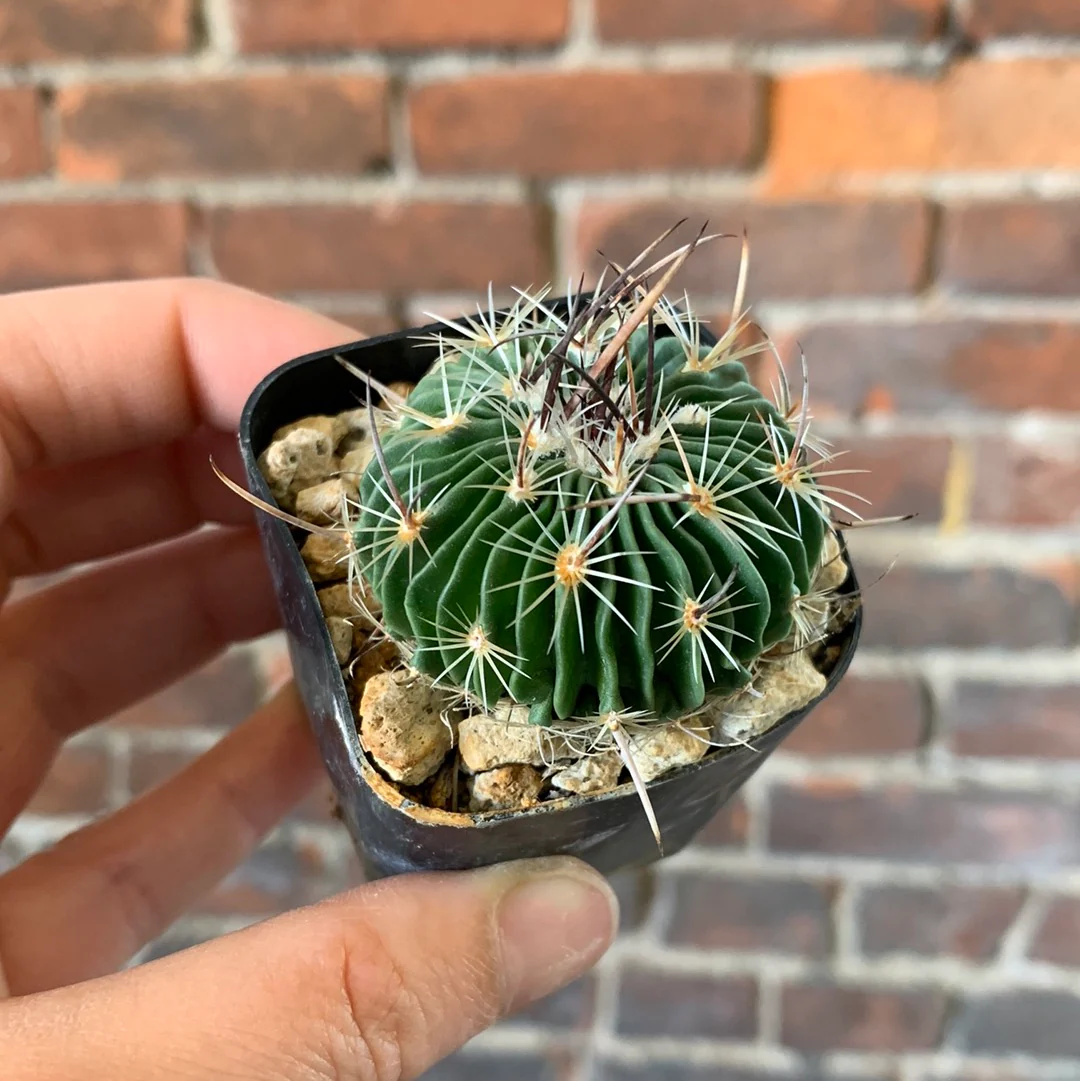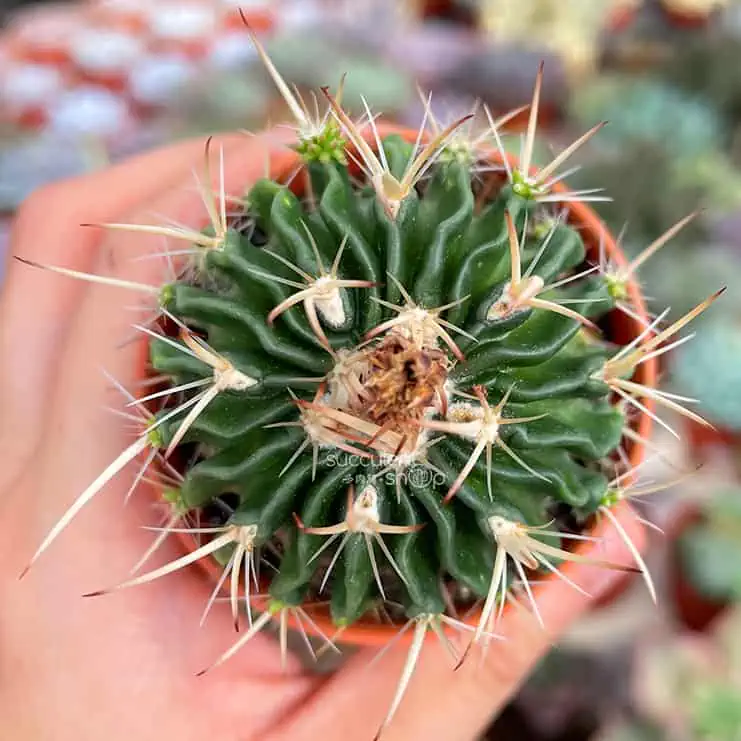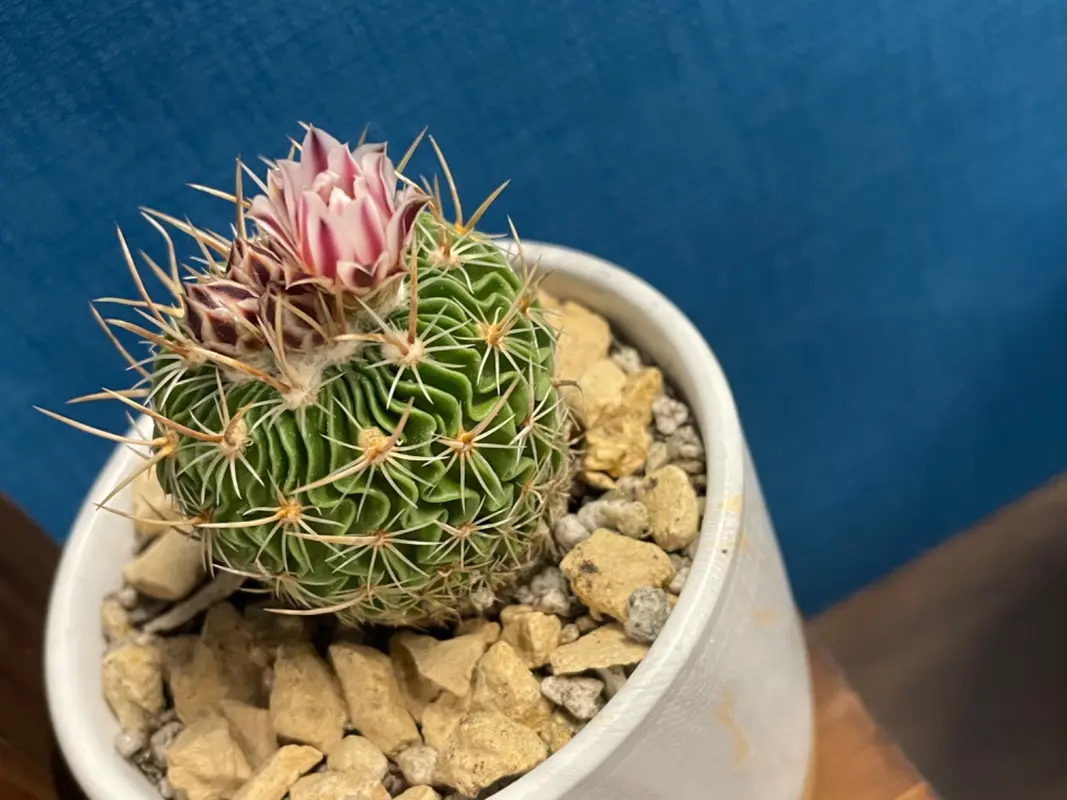HousePlantJoy is supported by our audience. When you purchase through one of our links, we may earn a small affiliate commission. As an Amazon Associate I earn from qualifying purchases. Your cost is not affected.
==================
So, I’ve been getting into indoor gardening lately, and let me tell you, it’s been quite the ride. One plant that’s caught my attention is the brain cactus. Yep, you heard me right! I’ve managed to grow one successfully, and it’s been an experience with this unique cactus.
I’ve picked up some useful tips along the way and am excited to share them with you. That’s why I’ve put together this Ultimate Guide to Growing a Brain Cactus Indoors. It’s got everything I’ve learned, from the best soil mix to how much sunlight these quirky little plants need. So, let’s dive in together and explore the fascinating world of brain cacti!
Unveiling the Secrets: Mastering Indoor Brain Cactus Cultivation
Photo by: Etsy
The Brain Cactus, scientifically known as Stenocactus Multicostatus, is a captivating succulent that has piqued the interest of plant enthusiasts worldwide. Its unique shape and texture, resembling the convoluted folds of a human brain, earned it the common name “Brain Cactus.” Native to central Mexico and belonging to the Cactaceae family, this small plant is a rare form that intrigues any collection.
Measuring around 2.5 inches in height, the Brain Cactus boasts wrinkled and wavy ribs, setting it apart from its cactus cousins. Its slow growth rate and compact size. Thriving in arid regions, the Brain Cactus craves direct sunlight and full exposure to the sun.
With its shallow root system, it flourishes in succulent soil mixes, making potting an optimal choice. Interestingly, it shares its brain-like appearance with its cousin, the Mammillaria Elongata Cristata. If you’re seeking a visually striking and rare addition to your succulent collection, the Brain Cactus will impress.
Key Highlights
- The Brain Cactus, also known as Stenocactus Multicostatus, is a unique, popular succulent native to Central Mexico.
- While the Brain Cactus, scientifically known as Stenocactus Multicostatus, is the most commonly recognized type of brain cactus, other species and cultivars are worth exploring.
- The Brain Cactus’s unique shape and texture make it a great centerpiece for creative displays.
- Unveil the secrets of mastering indoor brain cactus cultivation with key care tips, including light exposure, watering practices, soil requirements, fertilizing, temperature and humidity preferences, repotting guidelines, and troubleshooting common issues.
- Explore propagation methods such as offsets (pups) and seeds to multiply your Brain Cactus collection.
Exploring Diversity: A Guide to the Various Types of Brain Cacti
Photo by: LLIFLE
While the Brain Cactus, scientifically known as Stenocactus Multicostatus, is the most commonly recognized type, there are other species and cultivars worth exploring. These variations offer unique growth patterns, colors, and sizes that can add diversity to your succulent collection.
One popular variety is the Mammillaria Elongata Cristata, the “Crested Brain Cactus.” This type of brain cactus features a crested growth habit, resulting in a fan-like or wave-like appearance. It is a mutation of the regular Brain Cactus and is highly sought after by succulent enthusiasts, especially those fascinated by its unique crested form.
If you found the Brain Cactus amazing due to its form, here’s a video showcasing other rare cactus forms that might also amaze you.
By: Señor Cactacea
Creative Ways to Showcase Your Brain Cactus
Photo by: Desert Rose Cactus
The Brain Cactus’s unique shape and texture make it a great centerpiece for creative displays. Here are some creative ways to showcase your Brain Cactus:
- Terrariums: Place your brain cactus in a glass terrarium to create a mini desert landscape. Add sand, rocks, and other succulents to create a beautiful display.
- Hanging Planters: Hang your Brain Cactus in macrame plant hangers or other decorative planters to add visual interest and save space.
- Stylish Containers: To showcase your brain cactus, choose unique containers, such as ceramic pots or geometric planters.
- Tabletop Arrangements: Arrange multiple Brain Cacti of different sizes on a tabletop or shelf to create a stunning display. Add decorative rocks or pebbles for an extra touch of style.
- Pairing with Other Plants: Combine your Brain Cactus with other succulents or cacti to create a visually interesting arrangement. Play with different shapes and colors to add depth and variety.
Using these creative display ideas, you can showcase the beauty of your Brain Cactus and create a visually stunning centerpiece.
Essential Care for Brain Cactus
Photo by: Succulent and Cactus Malaysia
Let’s break down how to care for your Stenocactus Multicostatus, also known as the Brain Cactus, in a way that’s easy to understand:
Light
The Stenocactus Multicostatus, commonly called the Brain Cactus, flourishes in bright sunlight because of its folded and wrinkled appearance. While it can tolerate some light shade, particularly during the hottest parts of the afternoon, south-facing windows are optimal for indoor cultivation of these cacti, especially in warmer climates.
Watering
Like most cactus and succulent varieties, these cacti are very drought-tolerant and prefer to be on the dry side. Water your cacti when the soil is dried out. During the summer, you can water them every 10-14 days, allowing the water to drain completely from the pot through the drainage hole. In the winter, water very infrequently, perhaps even once a month, or even suspend watering altogether if your space tends to be cooler. Remember, giving them too little water is better than too much.
Soil
The most important aspect of watering Stenocactus Multicostatus is to use a well-draining soil mix. A standard cactus or succulent mix will work well, or you can create your own by mixing potting soil with perlite or sand.
Fertilizing
During the growing season (from early spring to early fall), you can fertilize your Stenocactus Multicostatus once a month. However, they are not heavy feeders and can survive without fertilizer.
Temperature and Humidity
Stenocactus Multicostatus prefers warm temperatures and can tolerate heat well. It can live into temperatures as high as 100°F (38°C). However, it is not frost-hardy and should be protected from freezing temperatures. If you live in a cold climate, you must bring your Stenocactus indoors in winter.
Like most succulents, Stenocactus Multicostatus prefers environments with little humidity, reminiscent of their native desert habitats. Avoiding excess humidity is essential, as it can lead to issues like root rot and fungal diseases. Aim to maintain humidity levels around 30-40% to ensure the health and vitality of your brain cactus.
Repotting
Repot only when the cactus has outgrown its pot if the soil has become compacted, or if you notice poor drainage causing issues like root rot. The best time to repot is in early spring, allowing the cacti to adjust to their new surroundings and resume their natural growth pattern.
With proper care, your Stenocactus Multicostatus can thrive for many years. It is a relatively low-maintenance cactus and a great choice for beginner cactus enthusiasts.
Propagation of Brain Cactus
Photo by: Plant Desert
So, when it comes to multiplying your Stenocactus Multicostatus, you’ve got a couple of easy methods up your sleeve:
Offsets (Pups)
This is the go-to method for most people, and for good reason—it’s a breeze. These cacti are pretty generous and sprout small offsets, also known as pups, right at their base. Here’s how you can do it:
- Spot the Pups: Look for these little bulbous growths with roots sprouting at the bottom of the big cactus.
- Separation: Once the pups are a decent size and have their own roots, gently snip them off from the parent plant using sanitized pruning shears or a sharp knife.
- Callousing: Let the cut end of the pup or woody stem cuttings dry out for a few days. This helps prevent any nasty rot once you plant it.
- Planting: Get a pot ready with some well-draining cactus mix. Make a little hole in the soil and pop the pup in there, ensuring the roots are covered.
- Watering: Ease up on the watering at first—just enough to moisten the soil. Too much water can spell trouble, especially in the beginning.
Seeds (Less Common)
If you’re feeling adventurous, you can give seed propagation a shot. It’s less common, but it’s worth a try. Here’s the lowdown:
- Get Some Seeds: You might find Stenocactus Multicostatus seeds at specialized nurseries or online shops that sell cacti and succulents.
- Planting: Grab a shallow tray and fill it up with some well-draining cactus mix. Give it a light sprinkle of water to moisten the soil. Sow the seeds on the surface and gently Place a thin layer of sand over them.
- Light and Heat: These little guys like bright, indirect light and warmth, so they’re cozy at around 70-80°F (21-27°C).
- Keep It Moist: Keep the soil damp, but don’t drown it. Those seeds might take a few weeks to wake up and sprout.
- TLC for Seedlings: Once they start popping up, thin them out if it gets crowded, and make sure they get the light and water they need as they grow.
Troubleshooting Common Issues
While the Brain Cactus is generally a resilient plant, it can sometimes face challenges. Here are some common issues you may encounter with your Brain Cactus and how to troubleshoot them:
- Pests: Look for common pests such as mealybugs and scale insects. Treat Pests infestations using insecticidal soap or neem oil.
- Diseases: Excessive watering may result in root rot and susceptibility to fungal diseases. To mitigate these risks, ensure adequate drainage and adjust your watering schedule accordingly.
By promptly addressing these issues and adjusting your care routine accordingly, you can ensure the continued health and vitality of your Brain Cactus.
Here’s an additional video about Stenocactus Multicostatus.
By: Desert Plants of Avalon
Cultivating Indoor Wonder: Mastering the Brain Cactus Experience
Mastering the indoor cultivation of the Brain Cactus, scientifically known as Stenocactus Multicostatus, unveiled a world of fascination and creativity for plant enthusiasts. With its captivating resemblance to the convoluted folds of a human brain and myriad diverse varieties, the Brain Cactus presented an unparalleled and visually striking enhancement to any succulent collection, alongside endless creative display opportunities.
By understanding its essential care requirements, including light exposure, watering practices, soil preferences, temperature and humidity needs, and propagation techniques, enthusiasts could ensure the health and vitality of their Brain Cactus plants. Additionally, troubleshooting common issues such as pests and diseases empowered growers to maintain optimal growing conditions and preserve the beauty of their plants.
Whether seasoned, succulent enthusiasts or beginner cactus gardeners, the Brain Cactus offers endless possibilities for exploration and creativity, making it a cherished and rewarding indoor plant. With proper care and attention, Brain Cacti thrived and captivated admirers with their unique charm for years.
Visit Houseplant Joy for expert tips, curated plant selections, and everything you need to cultivate a thriving indoor oasis. Let the joy of houseplants enrich your life today!
Frequently Asked Questions
How Often Should I Water My Brain Cactus?
Aim for about every 2-4 weeks during the growing season and reduce frequency during winter dormancy.
Can Excessive Moisture Damage the Plant?
Excessive moisture can damage your Stenocactus Multicostatus. Brain cacti hail from arid regions with low humidity and infrequent rainfall. Consider the region from which they originate—a place that remains dry for most of the year, punctuated by a brief, intense rainy season characterized by a short drenching rainy season. Their physiology is adapted to conserve water; excess moisture disrupts this balance.
Do I need to prune my Stenocactus Multicostatus?
Trimming a Stenocactus Multicostatus, commonly called the Brain Cactus, is typically unnecessary and may even harm its well-being.
Join the Houseplant Joy Community: Let’s Grow Together!
Hey plant lovers! 🌿 Ready to take your plant game to the next level? Dive into the green goodness with us!
Follow our journey on Facebook, Instagram, Pinterest, Twitter, YouTube, and TikTok for insider tips, fun content, and real talk about all things plants.
Let’s share the joy of houseplants together! Come on, let’s make our homes greener, one leaf at a time!


